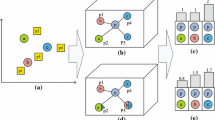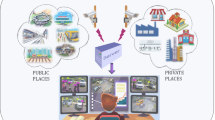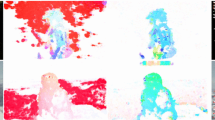Abstract
Video-based action recognition in realistic scenes is a core technology for human–computer interaction and smart surveillance. Although the trajectory features with the bag of visual words have confirmed promising performance, spatiotemporal interactive information cannot be effectively encoded which is valuable for classification. To address this issue, we propose a spatiotemporal semantic feature (ST-SF) and implement the conversion of it to the auxiliary criterion based on the information entropy theory. First, we present a text-based relevance analysis method to estimate the textual labels of objects most relevant to actions, which are employed to train the more targeted detectors based on the deep network. False detections are optimized by the inter-frame cooperativity and dynamic programming to construct the valid tubes. Then, we design the ST-SF to encode the interactive information, and the concept and calculation of feature entropy are defined based on the spatial distribution of ST-SFs on the training set. Finally, we achieve a two-stage classification strategy using the resulting decision gains. Experimental results on three publicly available datasets demonstrate that our method is robust and improves upon the state-of-the-art algorithms.










Similar content being viewed by others
References
Laptev, I.: On space-time interest points. Int. J. Comput. Vis. 64(2), 107–123 (2005)
Wang, H., Kläser, A., Schmid, C., Liu, C.L.: Dense trajectories and motion boundary descriptors for action recognition. Int. J. Comput. Vis. 103(1), 60–79 (2013)
Yi, Y., Wang, H.: Motion keypoint trajectory and covariance descriptor for human action recognition. Vis. Comput. 34(3), 391–403 (2018)
Wang, H., Oneata, D., Verbeek, J., Schmid, C.: A robust and efficient video representation for action recognition. Int. J. Comput. Vis. 119(3), 219–238 (2016)
Li, Y., Ye, J., Wang, T., Huang, S.: Augmenting bag-of-words: a robust contextual representation of spatiotemporal interest points for action recognition. Vis. Comput. 31(10), 1383–1394 (2015)
Dawn, D.D., Shaikh, S.H.: A comprehensive survey of human action recognition with spatio-temporal interest point (STIP) detector. Vis. Comput. 32(3), 289–306 (2016)
Wang, H., Ullah, M.M., Kläser, A., Laptev, I., Schmid, C.: Evaluation of local spatio-temporal features for action recognition. In: British Machine Vision Conference, pp. 124.1-124.11 (2009)
Yi, Y., Zheng, Z., Lin, M.: Realistic action recognition with salient foreground trajectories. Expert Syst. Appl. 75, 44–55 (2017)
Peng, X., Wang, L., Wang, X., Qiao, Y.: Bag of visual words and fusion methods for action recognition: comprehensive study and good practice. Comput. Vis. Image Underst. 150(C), 109–125 (2016)
Jégou, H., Perronnin, F., Douze, M.: Aggregating local image descriptors into compact codes. IEEE Trans. Pattern Anal. Mach. Intell. 34(9), 1704–1716 (2012)
Simonyan, K., Zisserman, A.: Two-stream convolutional networks for action recognition in videos. In: International Conference on Neural Information Processing Systems, pp. 568–576 (2014)
Varol, G., Laptev, I., Schmid, C.: Long-term temporal convolutions for action recognition. IEEE Trans. Pattern Anal. Mach. Intell. 40(6), 1510–1517 (2018)
Carreira, J., Zisserman, A.: Quo vadis, action recognition? a new model and the kinetics dataset. In: IEEE Conference on Computer Vision and Pattern Recognition, pp. 6299–6308 (2017)
Tran, D., Wang, H., Torresani, L.: A closer look at spatiotemporal convolutions for action recognition. In: IEEE Conference on Computer Vision and Pattern Recognition, pp. 6450–6459 (2018)
Hara, K., Kataoka, H., Satoh, Y.: Can spatiotemporal 3d cnns retrace the history of 2d cnns and imagenet? In: IEEE Conference on Computer Vision and Pattern Recognition, pp. 6546–6555 (2018)
Krishnan, K., Prabhu, N., Babu, R.V.: ARRNET: action recognition through recurrent neural networks. In: IEEE International Conference on Signal Processing and Communications, pp. 1–5 (2016)
Prest, A., Ferrari, V., Schmid, C.: Explicit modeling of human-object interactions in realistic videos. IEEE Trans. Pattern Anal. Mach. Intell. 35(4), 835–848 (2013)
Eum, S., Reale, C., Kwon, H., Bonial, C., Voss, C.: Object and text-guided semantics for CNN-based activity recognition. In: IEEE International Conference on Image Processing, pp. 1–5 (2018)
Jain, M., Gemert, J.C.V, Snoek, C.G.M.: What do 15,000 object categories tell us about classifying and localizing actions?. In: IEEE Conference on Computer Vision and Pattern Recognition, pp. 46–55 (2015)
Wu, Z., Fu, Y., Jiang, Y.G., Sigal, L.: Harnessing object and scene semantics for large-scale video understanding. In: IEEE Conference on Computer Vision and Pattern Recognition, pp. 3112–3121 (2016)
Heilbron, F.C., Barrios, W., Escorcia, V., Ghanem, B.: SCC: semantic context cascade for efficient action detection. In: IEEE Conference on Computer Vision and Pattern Recognition, pp. 1454–1463 (2017)
Liu, B., Wu, H., Su, W.: Rotation-invariant object detection using Sector-ring HOG and boosted random ferns. Vis. Comput. 34(5), 707–719 (2018)
Redmon, J., Divvala, S., Girshick, R., Farhadi, A.: You only look once: unified, real-time object detection. In: IEEE Conference on Computer Vision and Pattern Recognition, pp. 779–788 (2016)
Redmon, J., Farhadi, A.: YOLOv3: an incremental improvement. computer research repository, arXiv. 1804.02767 (2018)
Mikolov, T., Sutskever, I., Chen, K., Corrado, G.S.: Distributed representations of words and phrases and their compositionality. In: International Conference on Neural Information Processing Systems, pp. 3111–3119 (2013)
Jhuang, H., Gall, J., Zuffi, S., Schmid, C.: Towards understanding action recognition. In: International Conference on Computer Vision, pp. 3192–3199 (2013)
Zhang, W., Zhu, M., Derpanis, K.G.: From actemes to action: a strongly-supervised representation for detailed action understanding. In: International Conference on Computer Vision, pp. 2248–2255 (2013)
Liu, J., Luo, J.: Recognizing realistic actions from videos “in the wild”. In: IEEE Conference on Computer Vision and Pattern Recognition, pp. 1996–2003 (2009)
Lin, T.Y., Maire, M., Belongie, S., Hays, J., Perona, P., Ramanan, D., Dollar, P., Zitnick, C.L.: Microsoft COCO: common objects in context. In: European Conference on Computer Vision, pp. 740–755 (2014)
Deng, J., Dong, W., Socher, R., Li, L.J., Li, K., Li, F.F.: Imagenet: a large-scale hierarchical image database. In: IEEE Conference on Computer Vision and Pattern Recognition, pp. 248–255 (2009)
Gkioxari, G., Malik, J.: Finding action tubes. In: IEEE Conference on Computer Vision and Pattern Recognition, pp. 759–768 (2015)
LabelImg, GitHub, (2017). https://github.com/tzutalin/labelImg
Shannon, C.E.: Prediction and entropy of printed English. Bell Syst. Tech. J. 30(1), 50–64 (1951)
Ma, L., Lu, J., Feng, J., Zhou, J.: Multiple feature fusion via weighted entropy for visual tracking. In: International Conference on Computer Vision, pp. 3128–3136 (2015)
Grandvalet, Y., Bengio, Y.: Semi-supervised learning by entropy minimization. In: International Conference on Neural Information Processing Systems, pp. 529–536 (2005)
Vedaldi, A., Fulkerson, B.: VLFeat: an open and portable library of computer vision algorithms. In: International Conference on Multimedea, pp. 1469–1472 (2010)
Zolfaghari, M., Singh, K., Brox, T.: Eco: Efficient convolutional network for online video understanding. In: European Conference on Computer Vision, pp. 695–712 (2018)
Xie, S., Sun, C., Huang, J., Tu, Z., Murphy, K.: Rethinking spatiotemporal feature learning: Speed-accuracy trade-offs in video classification. In: European Conference on Computer Vision, pp. 305–321 (2018)
Peng, X., Zou, C., Qiao, Y., Peng, Q.: Action recognition with stacked fisher vectors. In: European Conference on Computer Vision, pp. 581–595 (2014)
Shao, L., Liu, L., Yu, M.: Kernelized multiview projection for robust action recognition. Int. J. Comput. Vis. 118(2), 115–129 (2016)
Jung, H.J., Hong, K.S.: Modeling temporal structure of complex actions using bag-of-sequencelets. Pattern Recognit. Lett. 85(1), 21–28 (2017)
Nie, B.X., Xiong, C., Zhu, S.C.: Joint action recognition and pose estimation from video. In: IEEE Conference on Computer Vision and Pattern Recognition, pp. 1293–1301 (2015)
Zhang, G., Jia, S., Li, X.: Weighted score-level feature fusion based on Dempster–Shafer evidence theory for action recognition. J. Electron. Imaging 27(1), 013021 (2018)
Chéron, G., Laptev, I., Schmid, C.: P-CNN: pose-based CNN features for action recognition. In: International Conference on Computer Vision, pp. 3218–3226 (2015)
Cao, C., Zhang, Y., Zhang, C., Lu, H.: Action recognition with joints-pooled 3D deep convolutional descriptors. In: International Joint Conference on Artificial Intelligence, pp. 3324–3330 (2016)
Iqbal, U., Garbade, M., Gall, J.: Pose for action-action for pose. In: IEEE International Conference on Automatic Face and Gesture Recognition, pp. 438–445 (2017)
Ma, M., Marturi, N., Li, Y., Leonardis, A., Stolkin, R.: Region-sequence based six-stream CNN features for general and fine-grained human action recognition in videos. Pattern Recognit. 76(1), 506–521 (2018)
Gammulle, H., Denman, S., Sridharan, S., Fookes, C.: Two stream LSTM: a deep fusion framework for human action recognition. In: IEEE Winter Conference on Applications of Computer Vision, pp. 177–186 (2017)
Pan, Y., Xu, J., Wang, M.: Compressing recurrent neural networks with tensor ring for action recognition. In: AAAI Conference on Artificial Intelligence, pp. 4683–4690 (2019)
Tran, D., Bourdev, L., Fergus, R.: Learning spatiotemporal features with 3D convolutional networks. In: IEEE International Conference on Computer Vision, pp. 489–497 (2015)
Wang, L., Xiong, Y., Qiao, Y.: Convnet architecture search for spatiotemporal feature learning. Computer Research Repository, arXiv. 1605.08140 (2017)
Cao, C., Zhang, Y., Zhang, C., Lu, H.: Body joint guided 3-d deep convolutional descriptors for action recognition. IEEE Trans. Cybern. 48(3), 1095–1108 (2017)
Yu, T., Wang, L., Da, C.: Weakly semantic guided action recognition. IEEE Trans. Multimed. 21(10), 2504–2517 (2019)
Acknowledgements
This research is financially supported by the 2017 BJUT United Grand Scientific Research Program on Intelligent Manufacturing (No. 040000546317552) and the National Natural Science Foundation of China (Nos. 61175087, 61703012).
Author information
Authors and Affiliations
Corresponding author
Ethics declarations
Funding
This study was funded by the 2017 BJUT United Grand Scientific Research Program on Intelligent Manufacturing (Grant number 040000546317552) and the National Natural Science Foundation of China (Grant number 61175087, Grant number 61703012).
Conflict of Interest
The authors declare that they have no conflict of interest.
Additional information
Publisher's Note
Springer Nature remains neutral with regard to jurisdictional claims in published maps and institutional affiliations.
Rights and permissions
About this article
Cite this article
Meng, X., Zhang, G., Jia, S. et al. Auxiliary criterion conversion via spatiotemporal semantic encoding and feature entropy for action recognition. Vis Comput 37, 1673–1690 (2021). https://doi.org/10.1007/s00371-020-01931-4
Published:
Issue Date:
DOI: https://doi.org/10.1007/s00371-020-01931-4




